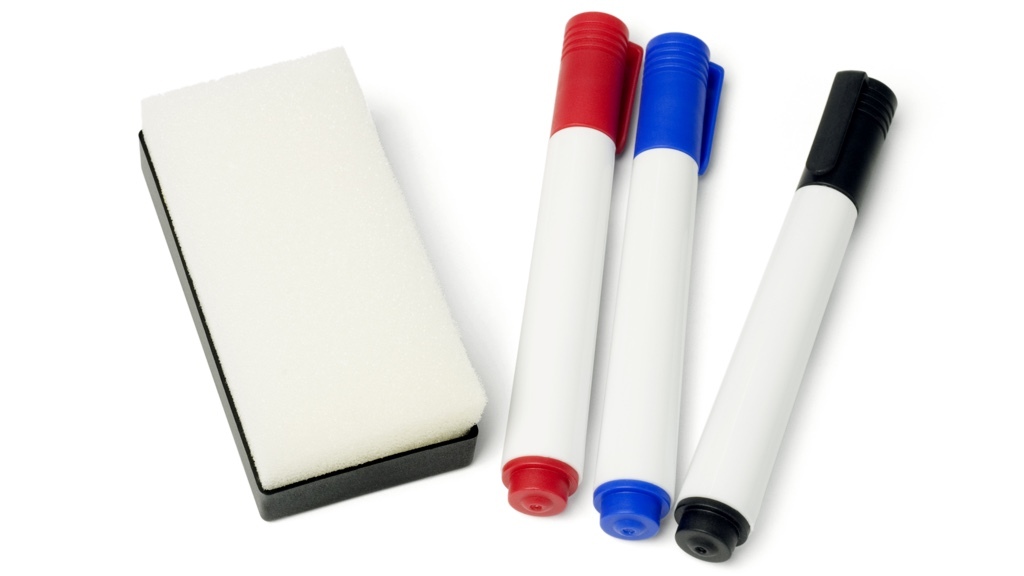How an increasingly white whiteboard relieves stress
Datum: 2022-11-17 11:00

There are times when thoughts of work just keep spinning through our mind. We have so many things going on now, and so many things to keep track of.
For you who prefer listening to reading, this post is also available as an episode of the “Done!” podcast:
Your head feels full to the brim with information and things you mustn’t forget, we are thinking of this, that and the other… And OH!…, and there comes a thought regarding something you simply cannot forget. The intensity of our current situation adds to the stress, and at least speaking for myself, makes me feel exhausted and weighted down.
Ten minutes with a colleague
Ylva wrote to me and shared her method for clearing her mind when there are simply too many thoughts spinning and she needs to get an overview of everything. I particularly liked one detail in her method, so allow me to share it with you.
She describes how she in situations like these ask a colleague for a brief meeting, say 5 – 10 minutes. She emphasizes that she wants to widen her perspectives and hence ask her colleague for specific tips on tangents to all the things that are on her mind which could get her to think differently about her problems and concerns. This is similar to part of the Whimbey TAPPS-method (Thinking Aloud Pair Problem Solving).
Emptying one’s mind
They meet in front of a whiteboard and Ylva writes up all the thoughts and issues that are cluttering her mind. She draws circles and arrows to show how the issues are interrelated and influence each other. The colleague thinks out loud and reflects on what she has written on the board. They make adjustments and complement the board’s content together. As soon as they conclude on a next step that should be taken regarding something, Ylva adds it to her to-do-list and as they resolve some aspect, thought or issue she completely erases it from the whiteboard.
… and the board
And as they go through everything that has been on her mind, and less and less items are left on the whiteboard, it becomes increasingly white again and the to-do-list gets filled with concrete tasks to make her progress. Finally the whiteboard is empty and Ylva describes how the things that previously distracted and bothered her now feel much lighter. This visual and symbolic aspect of how the whiteboard regains its whiteness as she becomes increasingly clear on what needs to be done, really appeals to me.
Do you feel like trying this method?
If so, do this
- If you have time to do so immediately, get yourself to a whiteboard. If you are busy and want to try this later, check you calendar and reserve a window of 15 minutes sometime in the next few days. If you do not have a colleague available, then do this on your own. If you do not have a whiteboard, do this digitally on your iPad or Android-tablet. If you do not have any digital tools at hand — simply grab an empty sheet of paper, a pencil and an eraser.
- Now empty out your thoughts onto the surface of your choice. Even if you are not in a chaotic situation at the moment, this will still benefit you, so write down all the work related issues which are on your mind at the moment. How extensive or large are the different ”things” in relation to each other? Where on the surface do you write them down in order to make them correspond to how they feel to you? How are they related?
- As soon as you think of something you can do about something, formulate a to-do-task and add it to your list.
- If you should feel that the map of all the things on your mind could be regarded as valuable reference information, take a picture of it before you begin erasing anything.
- You then erase every ”item” you find a solution for as soon as you have defined the first step you will take.
- Continue doing this until the entire surface is empty.
- Notice how this is making you feel. Relieved, like Ylva (and myself when I do this)? Eager to get started with the concrete tasks you have defined? Well, leave the exercise and get going then!
Empty and easy
If you make a visual depiction and sketch out all your ongoing things and thoughts, it is easier to see every thing in a much more balanced light and put all your engagements in the right proportion. Instead of having all these thoughts spinning round and round, you quiet and calm your mind and hence make it possible to break the more complex and conceptual into at least one smaller, concrete and more manageable first step which you can take and then be at least one step closer to resolving the whole situation or completing the task.
Plus, this way you are not constructing a map or overview that you need to save and keep somewhere. The result is rather emptiness, activity and progression. Less documents to handle and save, and more steps taken to progress forward.
Do you have any other ideas?
How do you create an overview and get clarity when your head is full of unresolved matters that keep spinning? Write to me and share your method. Perhaps you have an absolutely brilliant method which in an elegant manner helps you on days when things are as bad as they get.
(By the way, did you know that helping others might also relieve stress?)

If you want more tips on how to create good structure at work, there are many ways to get that from me - in podcasts, videos, books, talks and other formats.




